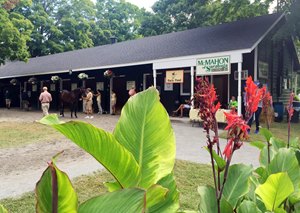New York-Bred Yearling Sale on a Roll


With the higher-profile Fasig-Tipton Saratoga sale now in the history books, many of the same consignors who had horses in that auction are gearing up for the New York-bred yearling sale.
On a five-year roll of steady increases, the Fasig-Tipton New York-bred sale takes place Aug. 13-14 in nightly sessions at Fasig-Tipton’s Humphrey S. Finney pavilion in Saratoga Springs, N.Y.
The New York-bred market is fueled in part by the lucrative New York Thoroughbred Breeding and Development Fund, which is expected to pay out more than $60 million this year—including some $18 million in awards to owners, breeders, and stallion owners.
Topped by a $350,000 Tiznow filly, last year the sale grossed a record $14,876,500, with an all-time high average price of $81,739 and co-record median of $65,000 for the 182 horses sold. As recently as 2010, the New York-bred sale had a mere 94 yearlings sell for $3,676,000 for an average of $39,106.
Along with the numbers, the quality of the horses in the restricted sale has improved. Statistics recently released by BloodHorse MarketWatch list it as a top-three ranked sale by average earnings per starter, percentage of winners sold with earnings of more than $150,000, and percentage of stakes winners from yearlings sold.
“We’ve seen over the last 10 years pretty remarkable growth and gains in the New York-bred sale due to the growth in quality of the horses being offered for sale,” Fasig-Tipton president Boyd Browning Jr. said. “The pedigrees have improved, the physical conformation have improved, and the horsemanship has really improved. The stallions in New York and the female families have gotten better. It’s a great program. The New York breeding program is the pre-eminent state-bred program in the United States.”
Carl McEntee, sales director at John Phillips’ Darby Dan Farm, said the development fund provides incentives to buyers that do not exist at some of the other upcoming yearling sales.
“I think with the later books (catalogs) at Keeneland and Fasig-Tipton October sale, they (buyers) are going to be very selective and it could be unpleasant for those other horses that don’t quite make the cut,” McEntee said. “But I don’t think the New York sale is affected by that because it is a different demographic because they are running for so much money."
“That sort of prize money is the incentive needed to create the middle market for that kind of sale,” said consignor Archie St. George, a Kentucky-based consignor whose St. George Sales topped the Fasig-Tipton July selected yearling sale in Lexington with a Curlin colt, and has 11 head entered in the New York-bred sale. “When you are able to run for that kind of money it is a good incentive to buy yearlings. It seems like the quality going to that sale gets better every year.”
The sale begins at 6:30 p.m. EDT daily.
